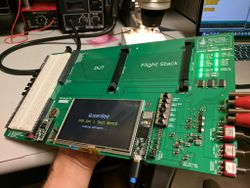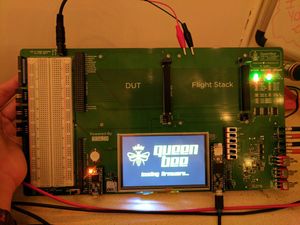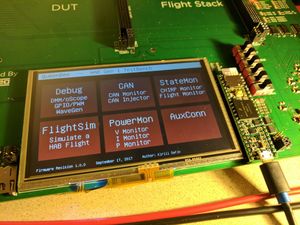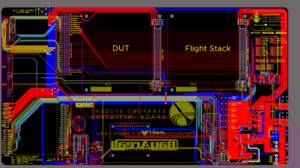Difference between revisions of "Balloons Gen 1 TestBench"
| (3 intermediate revisions by the same user not shown) | |||
| Line 1: | Line 1: | ||
| + | {{HONEY-sidebar | ||
| + | | header = QueenBee | ||
| + | | designer = Kirill Safin | ||
| + | | img link = File:QueenBee1.jpg | ||
| + | | techline = Balloons TestBench | ||
| + | | version = Generation I | ||
| + | | name = QueenBee | ||
| + | }} | ||
| + | |||
'''QueenBee''' is the first generation HONEY TestBench. QueenBee provides a number of utilities that allow for extensive & straightforward testing of new HONEY compliant boards, and for the prototyping of new designs & features on a breadboard, with access to the HONEY power, data, and CAN buses. | '''QueenBee''' is the first generation HONEY TestBench. QueenBee provides a number of utilities that allow for extensive & straightforward testing of new HONEY compliant boards, and for the prototyping of new designs & features on a breadboard, with access to the HONEY power, data, and CAN buses. | ||
| Line 29: | Line 38: | ||
To the left of the DUT Fixture, one can find the HONEY Pin Out. This faithfully replicates the HONEY power, data, and CAN buses to the exact pin number of each pin, but with standard pitch to allow for using jumper cables. That is, the entire 4x30 data bus, which is normally 2.00mm PC/104+, is now available in 4x30 2.54mm standard headers. You can use this as a faithful reference to see the exact pin mapping of the actual HONEY data bus, and to probe and scope specific lines, as well as use this pinout in conjunction with the breadboard to develop and testing a new project. | To the left of the DUT Fixture, one can find the HONEY Pin Out. This faithfully replicates the HONEY power, data, and CAN buses to the exact pin number of each pin, but with standard pitch to allow for using jumper cables. That is, the entire 4x30 data bus, which is normally 2.00mm PC/104+, is now available in 4x30 2.54mm standard headers. You can use this as a faithful reference to see the exact pin mapping of the actual HONEY data bus, and to probe and scope specific lines, as well as use this pinout in conjunction with the breadboard to develop and testing a new project. | ||
| − | The Power Bus, Data Bus, and CAN Bus are all found separately here, just as they would in an actual HONEY flight stack, and follow the same pinout. | + | The Power Bus, Data Bus, and CAN Bus are all found separately here, just as they would in an actual HONEY flight stack, and follow the same pinout. |
| + | |||
| + | [[File:QueenBee2.jpg | right| thumb | <center> QueenBee on boot-up </center>]] | ||
| + | [[File:QueenBee-SW.jpg | right| thumb | <center> QueenBee main screen </center>]] | ||
| + | [[File:QueenBee-routing.png | right| thumb | <center> QueenBee routing job </center>]] | ||
=== Venom Breakout === | === Venom Breakout === | ||
Latest revision as of 21:15, 28 September 2017
| QueenBee | |
|---|---|
| Part of the HONEY Architecture series & the HABEES series | |

| |
| Chief Designer | Kirill Safin |
| Technology Line | Balloons TestBench |
| Version | Generation I |
| Name | QueenBee |
| General | |
| HONEY Standards • Venom Breakout • Fang Breakout • Board Naming | |
| Core Software | |
| STINGR | |
| Core Avionics | |
| The Count | |
| Core Power | |
| Biscuit | |
| Core Peripherals | |
| Cobra • Viper • ProtoBee | |
| Core Radio | |
| Macaw | |
| Test & Prototype | |
| QueenBee | |
| Guides | |
| Making a HONEY Board • Using STINGR • Using QueenBee • Making a Prototype | |
| V • E | |
QueenBee is the first generation HONEY TestBench. QueenBee provides a number of utilities that allow for extensive & straightforward testing of new HONEY compliant boards, and for the prototyping of new designs & features on a breadboard, with access to the HONEY power, data, and CAN buses.
Operation
QueenBee has a number of features and functions, but can be broken down into a few discrete sections
- Stack Fixture
- DUT (Device Under Test) Fixture
- Breadboard
- HONEY Pin Out
- QueenBee Pin Out
- Venom Breakout
- 5" assistive display
- Teensy 3.2 Socket + microSD logger + Pin Out
- Teensy 3.6 QueenBee Master Computer
- Power Inputs & Power Regulation
- LED Indicators
These sections will be discussed individually in more depth below.
HONEY Fixtures
QueenBee comes with two fixtures -- one called the Stack Fixture and one called the DUT Fixture. The Stack Fixture, the right of the two fixtures, is meant to accept a multi-board HONEY flight stack. This is meant to be the exact flight stack you intend to fly your board with -- to best mimic the exact electrical connections and software your board will interact with.
The left fixture, called the DUT Fixture, is meant to accept your board, in this case, the DUT, or "Device Under Test" -- this fixture is meant to hold one board and one board only (although, electrically speaking, it can accept any number of boards).
By breaking the flight stack into two sets of boards -- yours, and everything else -- you will have the flexibility to more easily debug your board for issues -- both software and electrical. Having your board be totally visible allows for easy probing and scoping for electrical debugging, access to any possible buttons, jumpers, connectors, etc, that your board may have, and more.
It also permits altering the primary flight stack quickly & easily (by taking boards out and putting boards in) without swapping your board out or in. This can allow debugging possible conflicts you might have with specific boards, by swapping them in and out.
HONEY Pin Out
To the left of the DUT Fixture, one can find the HONEY Pin Out. This faithfully replicates the HONEY power, data, and CAN buses to the exact pin number of each pin, but with standard pitch to allow for using jumper cables. That is, the entire 4x30 data bus, which is normally 2.00mm PC/104+, is now available in 4x30 2.54mm standard headers. You can use this as a faithful reference to see the exact pin mapping of the actual HONEY data bus, and to probe and scope specific lines, as well as use this pinout in conjunction with the breadboard to develop and testing a new project.
The Power Bus, Data Bus, and CAN Bus are all found separately here, just as they would in an actual HONEY flight stack, and follow the same pinout.
Venom Breakout
To the left of the breadboard, there are two Venom Breakouts -- this allows for the testing of ProtoBee's and other cabled assemblies in conjunction with the QueenBee TestBench.
Teensy 3.2 Socket
As with ProtoBee and Cobra, QueenBee comes with a socket fit for a Teensy 3.2. While a portion of QueenBee is dedicated to testing newly made HONEY boards, the other portion of it is dedicated to allowing the prototyping, development, and testing of new projects -- whether they end up on a ProtoBee, Cobra, or as an actual HONEY board.
This prototyping/development portion of QueenBee is comprised of the Teensy 3.2 socket, micro SD data logger, Teensy Pin Out, and Breadboard. As with Cobra & Proto Bee, if you desire, you can insert a Teensy 3.2 into the socket to add an MCU to your project.
The Teensy 3.2, as in Cobra & ProtoBee, has all of its pins broken out onto a set of headers, which you can easily tap with jumper wires and connect to your breadboard project. A microSD socket and CAN Transceiever are also included, to mimic ProtoBee/Cobra, and provide all the standard functionality available to a HONEY board.
BreadBoard
As already mentioned, the Breadboard is the key part of QueenBee dedicated to prototyping and developing new projects for the HONEY stack. At the immediete right of the breadboard are pinouts for the power bus, data bus, CAN bus, and Teensy 3.2 -- all of the things you'd generally have accessible to you in a ProtoBee, Cobra, or an actual HONEY board. Between all of these, you should be able to test & try anything you'd like.
QueenBee Master Computer
QueenBee is equipped with a Teensy 3.6 that serves as the master computer for the TestBench. This Teensy serves a variety of purposes. Firstly, it controls and drives a set of 24 status LED's that provide a very quick picture of the state of the flight stack. Secondly, it listens to the CAN Bus and is able to read and output all STINGR Gestures. Third, it can be connected to a PC, where it will dump a large log over Serial (112500 baud) of all of the CAN, Serial, etc data it sees. This can help with debugging.
Fourth, and perhaps most useful, it drives and controls a large diagnostic 5" display found in the center of QueenBee, which has a number of useful functionalities, such as:
- Giving diagnostic feedback about various signal/power lines
- Outputting CAN messages directly to the display for you to see
- Outputting the CHIRP messages to the screen for you to see
- Showing the current pulled by the test fixture/breadboard on all power lines
However, its power is enhanced when considering the QueenBee Pin Out -- a set of headers by the breadboard directly connected to the QueenBee computer. This stack of headers has a variety of pins on it -- analog pins, DACs, PWM pins, Serial UART pins, etc.
In conjunction with the assistive display (which is touch screen), you can use any of these pins for debugging or testing your project. You can request QueenBee to provide a PWM voltage on a PWM output pin, act as a multimeter by sampling its analog pins, have it produce a sin wave (or other signals) using its DAC, and even function as a device to test your Serial connections with -- IE, it can output whatever it receives over one of its Serial pins, or whatever it sends, etc.
By using the QueenBee pinout and the assistive display, you have at the tip of your hands (a sort of low end, but still cool) signal generator, multimeter, and UART decoder.
Power Input & Regulation
On QueenBee, you have the choice of either using an actual HONEY BMS in the Flight Stack for all of your power regulation needs (a good thing to do to test actual real implementations of your board as it will fly), or, alternatively, use an external power supply to power all operations.
There are four inputs for external power from a power supply -- one for 4.2V, and one for 12V. These must be connected to two power supply outputs and common grounded at QueenBee.
If using an external power supply, you must flip the "BMS PRESENT?" switch to "NO" to enable external power. Enabling external power while the BMS is connected may cause permanent damage to the BMS.
There are two additional switches -- one to select whether the BMS is loaded with batteries (or, alternatively, whether to use the power supply to power the BMS) and one to select whether the flight stack has a 12V source (or, alternatively, whether to use the power supply).
For the first switch ("BATTERIES PRESENT?"), if flipped to "YES", QueenBee assumes the BMS is loaded with the batteries that will be powering everything. If flipped to "NO", QueenBee will provide the power supply 4.2V to the barrel jack connector located by the Stack Fixture. One must then connect a barrel jack-to-alligator-clip connector to this jack, and connect the alligator clips to the battery terminals of the BMS. In this fashion, QueenBee will provide an external 4.2V to act as the batteries, but allow the flight stack BMS to conduct all power regulation.
For the second switch ("PSU 12V?"), if flipped to "YES", QueenBee will use the attached 12V power supply for all 12V power rails. If flipped to "NO", QueenBee will assume a 12V supply is included in the flight stack -- and, if not, will leave the net floating.
In the case that the "BMS PRESENT?" switch is set to "NO", QueenBee will use its onboard power regulation circuitry to provide all of the power for the flight fixture, DUT fixture, pin outs, and teensies. It is worth noting that QueenBee uses identical circuitry to Biscuit, the Gen 2 HAB BMS -- in this sense, you will get an accurate portrayal of power regulation to some extent.
Post-power regulation, you may disable or enable any power line individually using the set of slide switches to the right of the QueenBee computer. This allows you to turn off supplies you don't need, supplies that are shorting, or resetting supplies to see if your board/project react appropriately to having certain power supplies reset or lost.
LED Indicators
At the very top right of QueenBee is a set of 24 LED's that provide feedback as to the state of a number of key variables. They indicate the nominality of various supply voltages, indicate the states of various HONEY system flags, and provide other visual feedback at a glance. They switch between being Green, Red, and off.


